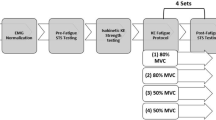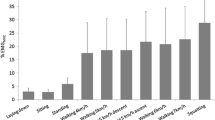Abstract
The aim of this study was to determine the power output and work done by different muscle groups at the hip and knee joints during a rising movement, to be able to tell the degree of activation of the muscle groups and the relationship between concentric and eccentric work. Nine healthy male subjects rose from a chair with the seat at knee level. The moments of force about the hip and knee joints were calculated semidynamically. The power output (P) and work in the different muscle groups surrounding the joints was calculated as moment of force times joint angular velocity. Work was calculated as: work = f Pdt. The mean peak concentric power output was for the hip extensors 49.9 W, hip flexors 7.9 W and knee extensor 89.5 W. This power output corresponded to a net concentric work of 20.7 J, 1.0 J and 55.6 J, respectively. There was no concentric power output from the knee flexor muscles. Energy absorption through eccentric muscle action was produced by the hip extensors and hip flexors with a mean peak power output of 4.8 W and 7.4 W, respectively. It was concluded that during rising, the hip and knee muscles mainly worked concentrically and that the greatest power output and work were produced during concentric contraction of the knee and hip extensor muscles. There was however also a demand for eccentric work by the hip extensors as well as both concentric and eccentric work by the hip flexors. The knee flexor muscles were unloaded.
Similar content being viewed by others
References
Arborelius UP, Wretenberg P, Lindberg F (1992) The effects of armrests and high seat heights on lower limb joint load and muscular activity during sitting and rising. Ergonomics 11:1377–1391
Burdett RG, Habasevich R, Pisciotta J, Simon SR (1985) Biomechanical comparison of rising from two types of chairs. Phys Ther 8:1177–1183
Cavagna GA, Komarek L, Mazzoleni S (1971) The mechanics of sprint running. J Physiol 217:709–721
Cavagna GA, Thys H, Zamboni A (1976) The sources of external work in level walking and running. J Physiol 262:639–657
Dahlkvist NJ, Mayo P, Seedhom BB (1982) Forces during squatting and rising from a deep squat. Eng Med 2:69–76
Dempster WT, Gaughran GRL (1967) Properties of body segments based on size and weight. Am J Anat 20:33–54
Elftman H (1940) The work done by muscles in running. Am J Physiol 129:672–684
Ellis MI, Seedhom BB, Amis AA, Dowson D, Wright V (1979) Forces in the knee joints whilst rising from normal and motorized chairs. Eng Med 1:33–40
Ericson MO (1988) Mechanical muscular power output and work during ergometer cycling at different work loads and speeds. Eur J Appl Physiol 57:382–387
Ericson MO, Bratt Å, Nisell R, Arborelius UP, Ekblom J (1986) Power output and work in different muscle groups during ergometer cycling. Eur J Appl Physiol 55:229–235
Garhammer J (1980) Power production by olympic weightlifters. Med Sci Sport Exerc 1:54–60
Gordon D, Robertson E, Winter DA (1980) Mechanical energy generation, absorption and transfer amongst segments during walking. J Biomech 13:845–854
Németh G, Ekholm J, Arborelius UP (1984) Hip joint load and muscular activation during rising exercises. Scand J Rehabil Med 16:93–102
Rizzardo M, Bay G, Wessel J (1988) Eccentric and concentric torque and power at the knee extensors of females. Can J Sports Sci 13:166–169
Seedhom BB, Terayama K (1976) Knee forces during the activity of getting out of a chair with and without the aid of arms. Biomech Eng 8:278–282
Williams KR, Cavanagh PR (1983) A model for calculation of mechanical power during distance running. J Biomech 16:115–128
Winter DA (1979) A new definition of mechanical work done in human movement. J Appl Physiol 46:79–83
Winter DA (1983) Moments of force and mechanical power output in jogging. J Biomech 16:91–97
Wretenberg P, Arborelius UP, Lindberg F (1993a) The effects of a pneumatic stool and a one-legged stool on lower limb joint load and muscular activity during sitting and rising. Ergonomics 5:519–535
Wretenberg P, Lindberg F, Arborelius UP (1993b) Effects of armrests and different ways of using them on hip and knee load during rising. Clin Biomech 8:95–101
Zarrugh MY (1981) Power requirements and mechanical efficiency of treadmill walking. J Biomech 14:157–165
Author information
Authors and Affiliations
Rights and permissions
About this article
Cite this article
Wretenberg, P., Arborelius, U.P. Power and work produced in different leg muscle groups when rising from a chair. Europ. J. Appl. Physiol. 68, 413–417 (1994). https://doi.org/10.1007/BF00843738
Accepted:
Issue Date:
DOI: https://doi.org/10.1007/BF00843738




